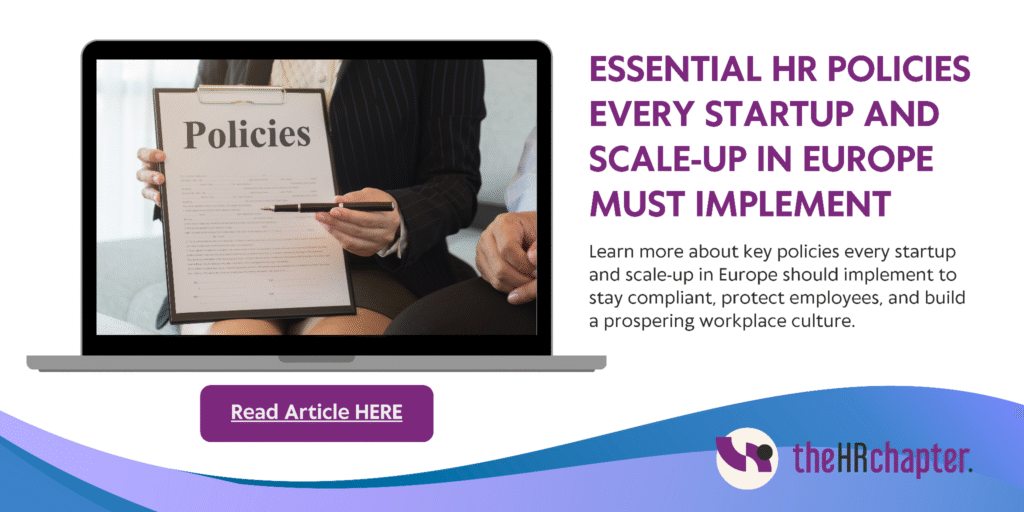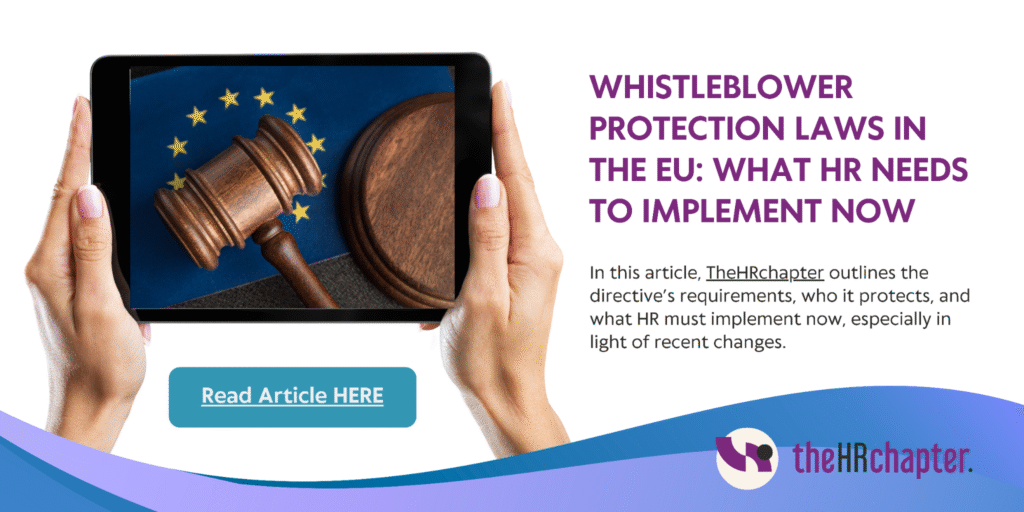EU Pay Transparency Directive: What Employers Must Do Before 2026

The European Union’s Pay Transparency Directive (Directive (EU) 2023/970) marks a significant shift in how employers across the EU must approach pay equity, transparency, and gender equality in the workplace.
For employers, this represents more than just a compliance milestone, it is a catalyst for cultural and operational change. The directive introduces mandatory transparency in recruitment, pay reporting, and employee rights to information. It also puts a spotlight on how companies define and evaluate “equal work” and “work of equal value.”
With the 2026 deadline approaching, employers must act now to assess their current practices, implement new processes, and ensure legal alignment across their operations. In this article, TheHRchapter outlines the key requirements of the Pay Transparency Directive, who it applies to, and what practical steps employers should take to ensure full compliance and to position themselves as fair, equitable, and attractive workplaces.
Background and scope
a. Legislative timeline
The EU Pay Transparency Directive (Directive (EU) 2023/970) was formally adopted by the European Parliament and the Council on May 10, 2023, and entered into force on June 6, 2023. Member States are required to transpose the directive into national law by June 7, 2026. After that date, employers across the EU must comply with the new obligations, subject to national variations in implementation.
While some Member States already have domestic pay transparency measures in place, the directive introduces a uniform baseline across the EU. Employers operating in multiple jurisdictions should therefore prepare for a coordinated compliance strategy, taking into account both the EU directive and national implementing measures.
b. Who it applies to
The directive applies to all employers within the EU, but certain obligations are phased in based on workforce size:
- All employers, regardless of size, must comply with job applicant transparency rules and employees’ right to pay information.
- Employers with 100 or more employees must publish periodic pay transparency reports, with the first reporting deadlines starting in 2027 (and in 2031 for companies with 100–149 employees).
- Employers with 250 or more employees may be required to conduct joint pay assessments if reporting reveals a gender pay gap of at least 5% that cannot be justified.
Employee thresholds are calculated per legal entity, not at group level, meaning that large corporate groups must assess reporting obligations for each subsidiary or branch separately.
c. Key definitions
Understanding the directive’s core terminology is essential for interpreting its obligations accurately:
- Pay Transparency: Refers to the right of workers and job applicants to access or receive information about pay levels, pay policies, and criteria used for determining pay and career progression. It also includes employer obligations to publicly disclose certain pay data.
- Pay Gap: Specifically the gender pay gap, defined as the difference in average gross earnings between female and male employees expressed as a percentage of male earnings. The directive requires detailed breakdowns of this gap, including by pay quartiles and job categories.
- Work of Equal Value: Jobs that may not be identical but are considered equivalent in terms of skills, effort, responsibility, and working conditions. Employers must ensure equal pay for such work and establish clear, objective, and gender-neutral job evaluation and classification systems to support this.
Core employer obligations under the directive
The EU Pay Transparency Directive introduces several mandatory requirements for employers, structured around the principles of openness, accountability, and equal pay for equal work. These obligations fall into three key categories: transparency in recruitment, access to pay information, and structured reporting/auditing mechanisms.
a. Pay transparency for job seekers
● Disclosing initial pay levels or ranges. Employers are required to provide job applicants with information about the starting pay level or the pay range for a given position. This must be disclosed either in the job posting itself or prior to the interview, ensuring that candidates have clear and upfront knowledge of potential remuneration.
● Prohibition on pay history inquiries. The directive prohibits employers from asking job applicants about their pay history, including salary or benefits earned in previous roles. This is a significant step toward breaking the cycle of historical pay discrimination and ensuring that remuneration is based on the value of the role, not prior compensation.
b. Access to pay information for employees
● Right to request pay comparisons. All employees have the right to request information on their individual pay level and on the average pay levels (broken down by sex) for categories of employees doing the same or equivalent work.
● Format and response deadlines. Employers must provide the requested information in a clear and accessible format and respond within a reasonable timeframe, as defined by national legislation.
c. Pay reporting and pay audits
Employers with 100 or more employees are required to publish pay transparency reports, typically on an annual or triennial basis (frequency varies depending on company size). These reports must include:
- Overall gender pay gap
- Median pay gap
- Gender gap in bonuses
- Proportion of employees receiving bonuses by gender
- Pay distribution by quartiles
- Information on the gender balance in management roles
The first reporting deadlines will begin in 2027 for companies with 150+ employees, and in 2031 for those with 100–149 employees.
If a company with 250 or more employees identifies a gender pay gap of 5% or more that is not justified by objective, gender-neutral factors—and does not rectify it within a reasonable period—it must conduct a joint pay assessment in collaboration with workers’ representatives.
This assessment must examine the pay structures, identify unjustified disparities, and set out corrective actions. It serves both as a compliance mechanism and a tool for meaningful organizational reform.
Preparing for compliance: practical steps for employers
To ensure readiness by the 2026 deadline, employers should start taking concrete actions now. Compliance will require not only technical adjustments but also cultural and structural changes. The following steps provide a practical roadmap for employers:
a. Internal pay structure review
To prepare for the EU Pay Transparency Directive, employers should conduct an internal review of their pay structures by implementing or refining transparent and objective job classification and evaluation systems. Tools like point-factor methods can help assess roles based on measurable criteria such as skills, responsibilities, and working conditions. Additionally, organizations must clearly define what constitutes “work of equal value” in alignment with EU standards, ensuring consistent and equitable pay practices across all roles.
b. Data collection & HR system adjustments
Employers must be able to collect and analyse sex-disaggregated pay data across all levels, including:
- Base salary and variable compensation
- Bonus allocation
- Pay progression over time
- Representation by gender in job categories and levels
Most legacy HR systems are not equipped to handle the granularity required by the directive. Employers should assess whether their HR Information Systems (HRIS) and payroll platforms can generate the required reports and support automated, disaggregated data tracking. Integration with DEI dashboards may also prove useful.
c. Policy and process updates
To comply with the directive, employers must update recruitment practices by including pay ranges in job postings and eliminating pay history questions during hiring. They should also formalize pay review and progression policies using objective, gender-neutral criteria and ensure these policies are accessible to staff. Additionally, companies must establish clear protocols for handling employee pay information requests, including assigning responsibility, setting response timelines, and maintaining confidentiality in line with data protection laws.
d. Training and internal communication
Provide targeted training on the directive’s requirements to HR teams, hiring managers, compensation analysts, and legal advisors. This should include how to handle requests, avoid bias in pay decisions, and prepare for audits.
Proactively inform employees about their new rights under the directive, how they can request pay information, and what changes to expect in recruitment or pay processes. Clear communication builds trust and mitigates confusion or suspicion.
Risks of non-compliance and national variations
Failure to comply with the EU Pay Transparency Directive exposes employers to both legal and reputational risks, with potential consequences varying by country due to national implementation choices.
- Non-compliance may lead to administrative fines, public reporting obligations, and heightened scrutiny from regulators, employees, and civil society organizations. These outcomes can damage an employer’s reputation, undermine employee trust, and affect talent attraction and retention.
- In addition, the directive significantly enhances employee protections, granting workers stronger rights to seek compensation for pay discrimination. Critically, it shifts the burden of proof onto the employer in discrimination claims, requiring the company to demonstrate that pay practices are lawful and non-discriminatory, rather than placing that burden on the employee.
Compounding these risks, the directive allows Member States to adopt stricter national rules. This means obligations may vary, with some countries opting for lower employee thresholds, more frequent reporting, or broader audit requirements. Employers operating across multiple jurisdictions must therefore track legislative developments closely, engage local legal and HR experts, and prepare for the most stringent applicable standards. Early alignment with these national variations is essential to avoid last-minute compliance issues and ensure a consistent, risk-managed approach across all EU operations.
Early action is not just advisable, it’s essential
The EU Pay Transparency Directive represents a major step toward closing the gender pay gap and fostering a more equitable workplace across Europe. While the obligations may seem complex, they also offer a valuable opportunity for employers to build transparency, trust, and a fairer organizational culture.
From updating recruitment processes and internal pay structures to preparing reporting mechanisms and training staff, compliance requires a coordinated, strategic approach. Employers that begin now will not only mitigate legal and reputational risks but also strengthen their employer brand and employee engagement.
Need expert support to navigate this transition? contact TheHRchapter today to assess your organization’s readiness, align your pay practices with EU requirements, and implement a compliance roadmap tailored to your business. Our team of HR and legal professionals is here to guide you every step of the way.
Spread the Word!
Enjoyed what you’ve read? Help others discover it too! 📢 Share this article and let’s keep the discussion going.
Related Reads: Check out these other Articles!
The Strategic Role of HR in Mergers and Acquisitions: Driving Smooth Transitions and Employee Alignment
The Strategic Role of HR in Mergers and Acquisitions: Driving Smooth Transitions and Employee Alignment…
HR’s Essential Role in Compliance and Due Diligence During Mergers
HR’s Essential Role in Compliance and Due Diligence During Mergers When we talk about mergers…
AI in Business Transformation: Moving Beyond the As-Is to the To-Be
AI in Business Transformation: Moving Beyond the As-Is to the To-Be Change is never easy….





